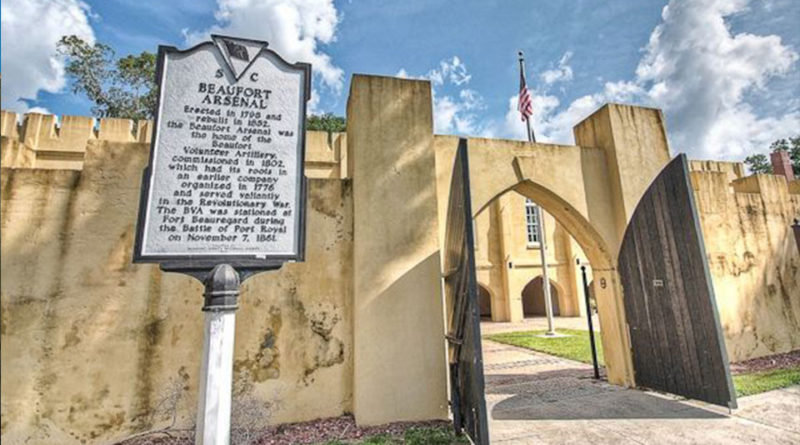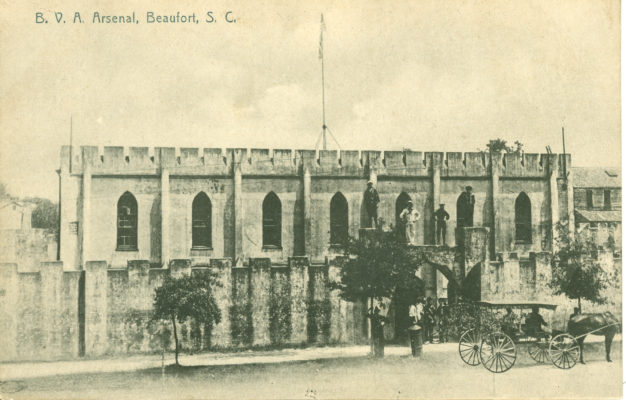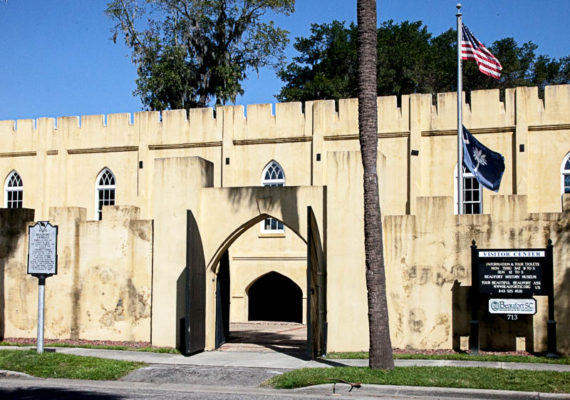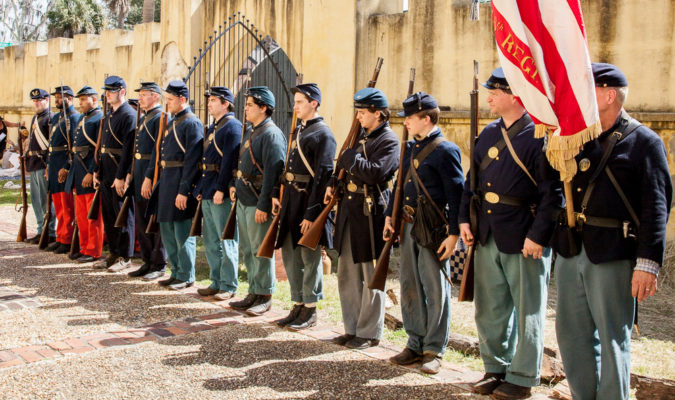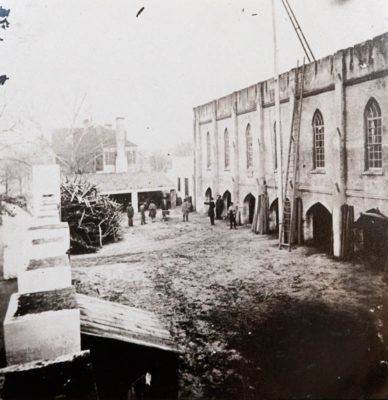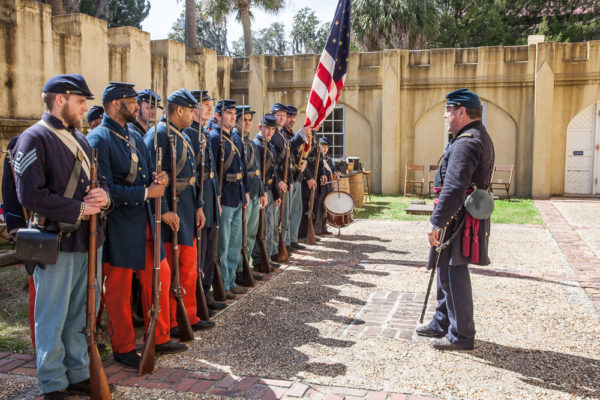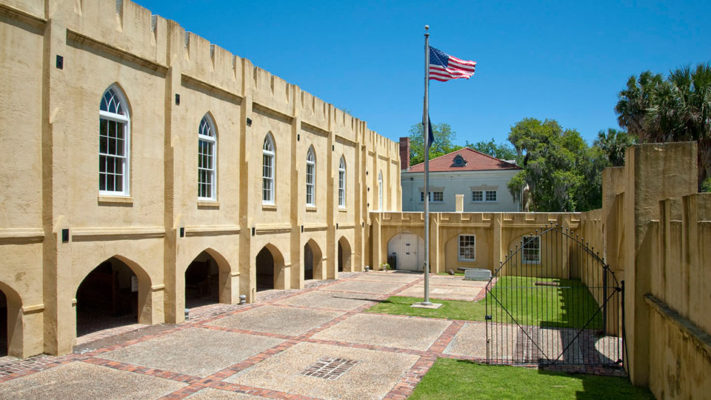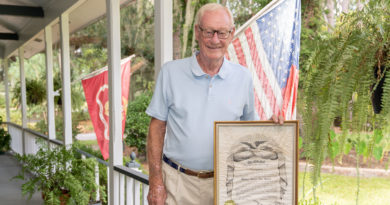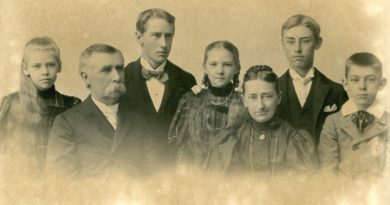The Beaufort Arsenal and Beaufort Volunteer Artillery
Protecting Beaufort for More than Two Centuries
story by CAROL LAUVRAY
The Beaufort Arsenal has been standing on Craven Street guarding this historic town for more than two centuries. The imposing walled edifice is one of the nation’s oldest arsenals, dating from 1798, and reflects the extensive military heritage of South Carolina’s Lowcountry and Beaufort’s role in many of America’s most consequential historic events, some originating long before the Arsenal was founded.
Beaufort’s Strategic Location
Beaufort is situated on Port Royal Island at the head of one of the largest and deepest natural harbors on the Atlantic Coast, Port Royal Sound. The Native Americans, Spanish, French, and English recognized this strategic location as an important commercial, agricultural, and military site as early as the 16th century. These three European nations fought to lay claim to the area for years before the English, with their powerful navy, prevailed. A small fort was erected on the Beaufort River in 1702, establishing the southern frontier of English North America. The town of Beaufort was founded in 1711, but in 1715 it was destroyed by the Yemassee Indians. The English re-established Beaufort the following year. In 1726, English and Scottish settlers built Fort Prince Frederick (which was located on what is the current-day grounds of the Beaufort Naval Hospital in Port Royal) to secure their position on the hostile frontier and encourage trade with friendly Native Americans. Fort Lyttleton, which was located on Spanish Point between Beaufort and Port Royal, was constructed to protect the Sea Islands during the French and Indian Wars (1756 – 1763). (Source: Beaufort Arsenal: Guarding the Nation’s Past. The Department of Defense Legacy Resource Management Program.)
Beaufort’s First Regiment
At the outbreak of the Revolutionary War in 1775, the Provincial Congress of South Carolina authorized the formation of a company of artillerymen (merged with the 4th Continental Artillery Regiment) to defend Fort Lyttleton. The regiment served at the fort until February 1779, when it evacuated and destroyed Fort Lyttleton as a British warship approached. The Beaufort militia units disbanded during the British occupation of South Carolina, but subsequently, the local patriot militia reoccupied Beaufort in November 1781.
Beaufort Arsenal Established in 1798
Not long after the Revolutionary War, the newly formed United States signed a treaty with Great Britain, resulting in its enemy France becoming more hostile towards the Americans. This threat prompted South Carolina to fortify its coastal ports and in 1792 a national militia act created new military units in South Carolina. In 1795 the state authorized $2,500 to build a powder magazine and laboratory to make shots and explosives in Beaufort. The Arsenal was built by Colonel Thomas Talbird and completed in 1798. The old artillery company was reorganized in 1800 as the Beaufort Volunteer Artillery (B.V.A.) and mustered in the Arsenal, along with the new Beaufort Volunteer Guards. Arsenal keeper Thomas Talbird, Jr. described the Arsenal building in 1825:
There are 2 buildings in size 20 x 30 feet each and 10 feet high, built of Tabby* and covered with tiles…One of which is used for the reception of arms, iron and tinware, etc., and the other for powder & articles composed of leather, wood, etc. A shed of 90 feet long extends from one of these buildings to the other and is 12 feet deep…The outer enclosure masonry 150 ft. by 61. And the wall is 10 feet high, also built of Tabby work.
* Tabby is a unique form of concrete made of the lime from burnt and crushed oyster shells and sand.
By 1820, the Beaufort Volunteer Artillery and the Beaufort Volunteer Guards were incorporated under state law as the Beaufort Artillery Society and were charged with drilling and exercising the Arsenal’s guns, including a battery of field pieces and several stands of arms. Also housed at the Arsenal was the Beaufort Beat Company, a civilian guard that patrolled the town against slave revolts. During this period, the militia units also served a social function, holding ceremonial parades and other events.
Beaufort’s Role in Secession and the Civil War
In the 1850s, Robert Barnwell Rhett led the Secessionist movement in Beaufort. The town’s citizens decided to increase military protection, so wealthy local cotton planters donated $2,835 to rebuild and reconstitute the old Arsenal. John Gibbes Barnwell, commander of the Beaufort Volunteer Artillery, is thought to have designed the 1852 restoration and expansion of the Arsenal, featuring pointed arched windows, parapets, and a stucco-covered masonry façade, along with the addition of a second floor hall. The Tabby wall enclosing the Arsenal was also replaced with a stuccoed brick wall. The renovated Arsenal was designed to house a garrison of 250 men and a battery of six guns.
In 1858, the Beaufort Volunteer Artillery, the Beaufort Beat Company, and the St. Helena Mounted Riflemen formed a local battalion headquartered at the Arsenal. At the outset of the War Between the States, some members of the B.V.A., commanded by Stephen Elliott, were present at the bombardment of Fort Sumter in Charleston Harbor in April 1861. During the summer of 1861, the regiment helped construct Fort Beauregard to guard the entrance to Port Royal Sound. On November 7, 1861, the U.S. Navy attacked and destroyed the Confederate forts on both sides of the Sound,Fort Beauregard on Bay Point and Fort Walker on Hilton Head, within just four hours, in a massive show of naval force. The citizens of Beaufort hastily packed up what they could carry and evacuated the town.
By December 5th, Union forces formally occupied Beaufort and the Arsenal, and its contents became part of the inventory of the U.S. Army, Department of the South. Union troops used the Arsenal to store quartermaster and artillery supplies for the rest of the war.
After retreating from Fort Beauregard, the B.V.A. joined the 9th South Carolina Regiment to defend Charleston and the Savannah Railroad. In 1862, the unit was mustered into Confederate service, serving under Captain (later Brigadier General) Stephen Elliott and Captain Henry “Hal” Stuart, and they fought at the battles of Coosawhatchee, Honey Hill, and Pocotaligo where they confronted Sherman’s troops. After the fall of Columbia and Charleston, the unit served in North Carolina at Averysboro and Bentonville. The regiment surrendered to Union troops at Durham Station, North Carolina on April 26, 1865.
The Reconstruction Era in Beaufort
Following the Civil War, the Beaufort Arsenal again housed state militia units, although those that fought for the Confederacy were banned from state service. Two new militia companies formed: the Beaufort Light Infantry (an African-American unit to which U.S. Congressman Robert Smalls, a former slave, belonged); and the Washington Light Infantry. After Reconstruction, South Carolina disbanded its black militia. The Washington Light Infantry was later phased out, so the re-formed Beaufort Volunteer Artillery was the Arsenal’s only remaining militia unit. In 1892, the B.V.A. was redesignated as the 3rd Division, Naval Militia, South Carolina National Guard. In 1898, at the outbreak of the Spanish-American War, the unit volunteered for service and manned naval batteries around Port Royal Sound throughout that conflict.
Beaufort Arsenal and the B.V.A. in the 20th and 21st Centuries
When the U.S entered World War I, the South Carolina National Guard was called into active federal service on April 6, 1917. During the war, the Sojourners’ Club, part of the War Camp Community Service, used the Arsenal as a community house for men in the armed service. By the mid-1920s, the Beaufort Volunteer Artillery had been redesignated three times and Beaufort was in the depths of an economic depression. With a shortage of manpower in Beaufort, the unit was mustered out of service in 1926. By 1930, the unit had been reorganized again as the 263rd Coast Artillery, South Carolina National Guard and was posted in Florence, then in Columbia.
As part of President Roosevelt’s “New Deal” program in the late 1930s, the Works Progress Administration and the South Carolina National Guard rehabilitated the Arsenal. Two single-story wings were added to the structure, in addition to extending the second floor over the existing one-story wings. After these renovations, the 263rd Coast Artillery returned to the Arsenal. The single-story east wing addition became a museum and relic room in 1939, the beginnings of the Beaufort Museum. The artillery unit continued to muster at the Arsenal until 1966 when the National Guard constructed a new armory behind the National Cemetery and Troop B 202 Cavalry, South Carolina National Guard donated the historic Arsenal building to the citizens of Beaufort.
Later, Beaufort Museum left the Arsenal for a time, but returned in 2014 as the reconstituted Beaufort History Museum located on the Arsenal’s second floor. Visitors who tour the Museum will learn about 500 years of Beaufort’s history and how this special place has shaped America from its beginnings. The Museum is open 10 AM to 4 PM daily Monday through Saturday, to share how Beaufort’s strategic geographical location and its unique ecology have influenced our nation’s evolution.

